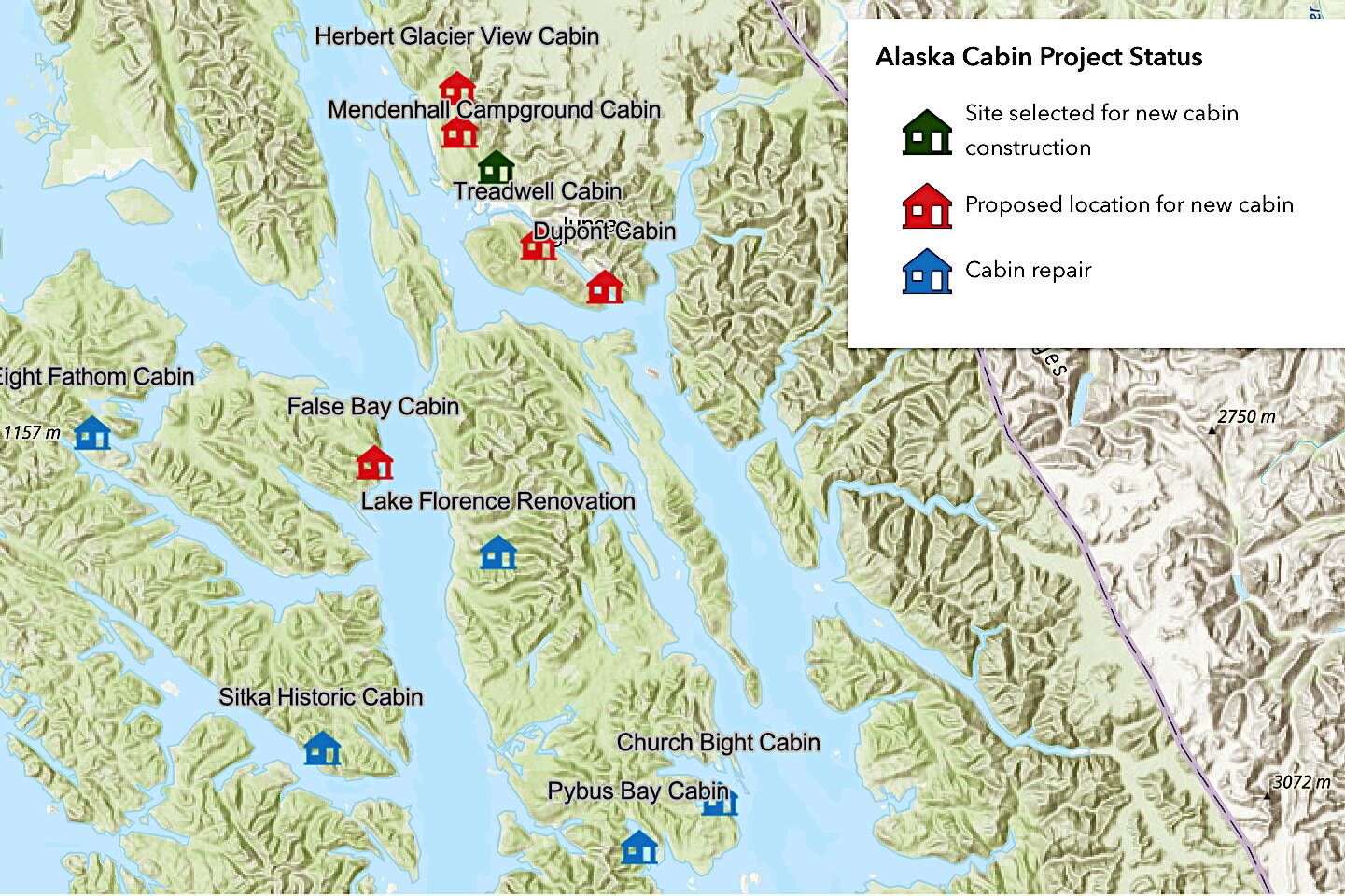A new U.S. Forest Service cabin may be constructed at Mendenhall Campground as soon as next summer and will be among the first built in the Tongass National Forest as part of a project intended to bring a dozen or more new cabins to the region during the coming years.
[Cabin fever fueled by Forest Service funds]
The locations of four new Tongass cabins, along with three in the Chugach National Forest, were announced Tuesday by the USFS, which plans to build about 25 new cabins and perform maintenance on many other existing ones. The funding for the project comes from a $14.4 million allocation the agency received in the 2021 Bipartisan Infrastructure Law, plus $3.7 million in matching funds raised by the National Forest Foundation.
The 69-site Mendenhall Campground, which has complete RV hookups and other facilities, isn’t exactly a pristine wilderness site for a USFS cabin like many existing in Juneau currently.
However, it was selected to be one of the first evaluated as a potential location in the Juneau-area as extensive preparatory work has already been done as part of a larger-scale overhaul of Mendenhall Glacier Recreation Area set for approval this fall, said James King, regional director of recreation, land and minerals for the USFS Alaska Region.
“For the last three years we’ve been working on this environmental impact statement, which we’re just finishing up the process on now,” he said. “This cabin in Mendenhall Campground was identified so its environmental work is nearly done, so we can move forward relatively quickly with building that.”
The decision to prioritize the Mendenhall cabin among those being built first in the Tongass for the project is also based on public comments that favored easy-access options, King said.
“We looked at the data that was coming in from our surveys where people were saying ‘yeah, we really liked these cabins that are close to communities, either a short boat ride or a short hike,’” he said. “But we also got a significant amount of comments from people saying ‘we need cabins that are truly accessible to the letter of the law.’ People in a wheelchair that can drive right up to it, could wheel right into it and feel like they have an experience out in the woods.”
Four other Juneau-area sites for future cabins are being evaluated and, while numerous factors remain unknown, King said the next local cabin may be a far more remote one within view of Herbert Glacier, which is accessed by a 10-mile trail north of town.
“You’re up there (near) the front of a glacier,” he said. “It’s recently been glaciated. The chances of heritage issues are probably smaller — we will still do the analysis, but we’re not on a beach where there may be a historic town site or village site. So the process may be slightly less intense.”
The hope is to build the Mendenhall Campground cabin next summer if contractors and supplies are in place, King said. Building one at a site such as Herbert Glacier will take longer both before it starts and is completed.
“Certainly one built in the month in the Mendenhall Campground should be a lot easier to build because you can drive equipment right to it and you’re not camped out in the woods versus building one,” he said. “At Herbert Glacier everything has to be flown in by helicopter and you’ve got to set up a remote camp for the crews to stay in as they build the thing.”
Two of the other new Tongass cabins on the initial list are at Signal Creek Campground at Ward Lake and the El Capitan Interpretive Site north of Naukati, according to a USFS press release. The fourth cabin is a reconstruction of the existing Anan Bay Cabin near Wrangell, which was heavily damaged by a recent windstorm.
“We went out there with engineers, took a look at it and decided that we could save the foundation,” King said. “But all of the wall logs and other things were in pretty poor condition, and we needed to start over with a new cabin on top of the foundation.”
The first round of cabins to be built in the Chugach National Forest are at Porcupine Campground in Hope, Meridian Lake in Seward and Trail River in Moose Pass, according to the USFS.
Six to seven new cabins are scheduled for construction annually, according to the agency. In addition, about 10 existing cabins will receive maintenance and repair.
“We need to do the environmental analysis, we need to do the heritage work, we need to go through those processes, and include the public to decide exactly where those would go,” King said. “We’ve got concepts, but we need to do all of that work to make sure that we’re putting them in the right place where people want them and that we aren’t putting them on an old archeological site or something like that.”
The National Forest Foundation continues to raise funds on top of the 20% match it is already providing to the federal funds, which may allow more cabins than the initially targeted 25 to be built, King said. He said project officials are also trying to evaluate sites without the goal of approving a predetermined number of them.
“We have a fixed amount of money and as you know, the cost of supplies and contracts and other things has gone up a lot since COVID,” he said. “And so rather than fixing on a hard number or saying ‘OK, this is the direction we’re going in, these are the ones we want to build first,’ if we can get these done less expensively we’ll do more in the end.”
More information about the Alaska Cabins Project, including an interactive map, is at www.fs.usda.gov/goto/cabin-project.
• Contact Mark Sabbatini at mark.sabbatini@juneauempire.com or (907) 957-2306.

